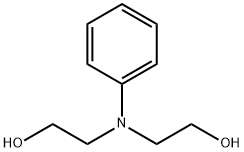N,N-DIMETHYL-M-TOLUIDINE
- CAS NO.:121-72-2
- Empirical Formula: C9H13N
- Molecular Weight: 135.21
- MDL number: MFCD00008305
- EINECS: 204-495-6
- SAFETY DATA SHEET (SDS)
- Update Date: 2025-09-25 17:15:13

What is N,N-DIMETHYL-M-TOLUIDINE?
Chemical properties
clear yellow liquid
The Uses of N,N-DIMETHYL-M-TOLUIDINE
N,N,3-Trimethylaniline, is an building block used for the synthesis of more complex compounds, such as BTK (Bruton''s tyrosine kinase) inhibitor.
The Uses of N,N-DIMETHYL-M-TOLUIDINE
N,N-Dimethyl-m-toluidine may be used in chemical synthesis studies.
General Description
A clear colorless liquid with an aromatic odor. Density 0.932 g / cm3 (Lancaster) and insoluble in water. Hence floats on water. Toxic by skin absorption and inhalation. Flash point 185°F. May release toxic vapors when burned.
Air & Water Reactions
Tends to darken upon exposure to air. Insoluble in water.
Reactivity Profile
N,N-DIMETHYL-M-TOLUIDINE neutralizes acids in exothermic reactions to form salts plus water. May be incompatible with isocyanates, halogenated organics, peroxides, phenols (acidic), epoxides, anhydrides, and acid halides. May generate hydrogen, a flammable gas, in combination with strong reducing agents such as hydrides.
Health Hazard
TOXIC; inhalation, ingestion or skin contact with material may cause severe injury or death. Contact with molten substance may cause severe burns to skin and eyes. Avoid any skin contact. Effects of contact or inhalation may be delayed. Fire may produce irritating, corrosive and/or toxic gases. Runoff from fire control or dilution water may be corrosive and/or toxic and cause pollution.
Fire Hazard
Combustible material: may burn but does not ignite readily. When heated, vapors may form explosive mixtures with air: indoors, outdoors and sewers explosion hazards. Contact with metals may evolve flammable hydrogen gas. Containers may explode when heated. Runoff may pollute waterways. Substance may be transported in a molten form.
Purification Methods
Reflux it for 3hours with 2 molar equivalents of Ac2O, then fractionally distil it under reduced pressure. Alternatively, dry over BaO, distil and store it over KOH. The hydrochloride has m 176o (from EtOH) and the picrate has m 131o. Methods described for N,N-dimethylaniline are applicable. [Beilstein 12 H 857, 12 III 1953, 12 IV 1815.]
Properties of N,N-DIMETHYL-M-TOLUIDINE
| Melting point: | -15 °C |
| Boiling point: | 215 °C(lit.) |
| Density | 0.93 g/mL at 25 °C(lit.) |
| refractive index | n |
| Flash point: | 185 °F |
| storage temp. | Sealed in dry,Room Temperature |
| form | Liquid |
| pka | 5.22±0.10(Predicted) |
| color | Clear yellow |
| BRN | 1422766 |
| CAS DataBase Reference | 121-72-2(CAS DataBase Reference) |
| EPA Substance Registry System | Benzenamine, N,N,3-trimethyl- (121-72-2) |
Safety information for N,N-DIMETHYL-M-TOLUIDINE
| Signal word | Danger |
| Pictogram(s) |
 Skull and Crossbones Acute Toxicity GHS06  Health Hazard GHS08 |
| GHS Hazard Statements |
H373:Specific target organ toxicity, repeated exposure H412:Hazardous to the aquatic environment, long-term hazard |
| Precautionary Statement Codes |
P273:Avoid release to the environment. P280:Wear protective gloves/protective clothing/eye protection/face protection. P314:Get medical advice/attention if you feel unwell. |
Computed Descriptors for N,N-DIMETHYL-M-TOLUIDINE
New Products
Indole Methyl Resin tert-butyl 9-methoxy-3-azaspiro[5.5]undecane-3-carboxylate Boc-His(Boc)-OH 2-CTC Resin 4-Chloro-7-tosy1-7Hpyrrolo[2,3-d]pyrimidine 5,7-Dibromo-1H-indole 2,5-dichloro-N-hydroxy-4,6-dimethylpyridine-3-carboximidamide 2,2-Dimethoxy-7-azaspiro[3.5]nonane hydrochloride 4-chloromethyl-5-methyl-1,3-dioxol-2-one (DMDO-Cl) R-2-BENZYLOXY PROPIONIC ACID 1,1’-CARBONYLDIIMIDAZOLE 1,1’-CARBONYLDI (1,2-4 TRIAZOLE) N-METHYL INDAZOLE-3-CARBOXYLIC ACID 4-((2-hydroxyethyl)thio)benzoic acid 1-(TERT-BUTOXYCARBONYL)-2-PYRROLIDINONE Methyl 6-methylnicotinate 3-Pyridineacrylic acid tert-Butyl carbazate TETRAHYDRO-2H-PYRAN-3-OL 2-((4-morpholinophenylamino) (methylthio) methylene) malononitrile 3-(4-morpholinophenylamino)-5-amino-1H-pyrazole-4-carbonitrile 2,4-dihydroxybenzaldehyde 1,3-Diethyl-1,3-Diphenylurea Methyl 2-methylquinoline-6-carboxylateRelated products of tetrahydrofuran








You may like
-
 N,N-Dimethyl-m-toluidine 98%View Details
N,N-Dimethyl-m-toluidine 98%View Details -
 N,N-Dimethyl-m-toluidine CAS 121-72-2View Details
N,N-Dimethyl-m-toluidine CAS 121-72-2View Details
121-72-2 -
 N,N,3-Trimethylaniline 97% CAS 121-72-2View Details
N,N,3-Trimethylaniline 97% CAS 121-72-2View Details
121-72-2 -
 Pyridine 99.5% HPLC /UV SpectroscopyView Details
Pyridine 99.5% HPLC /UV SpectroscopyView Details
110-86-1 -
 Piperazine Spot supply, best priceView Details
Piperazine Spot supply, best priceView Details
110-85-0 -
 Dibutyl PhthalateView Details
Dibutyl PhthalateView Details
84-74-2 -
 Imidazole Spot supply, competitive priceView Details
Imidazole Spot supply, competitive priceView Details
288-32-4 -
 Thiourea 99% ARView Details
Thiourea 99% ARView Details
62-56-6
